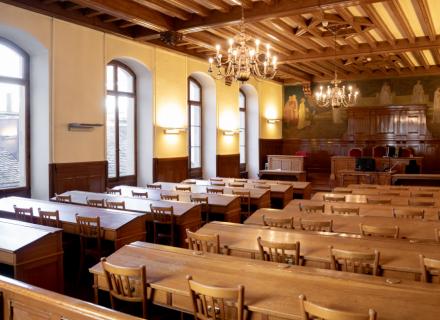The functioning of the justice system and its 3 branches

The functioning of the justice system and its 3 branches
The Judiciary Power is composed of the Public Prosecutor's Office and the courts of first and second instance. It groups together all the civil, criminal and public law judicial authorities responsible for dispensing justice in Geneva.
There are 3 main branches of justice:
To understand these different branches, here are 3 short films that will help you to better understand the functioning of justice in Geneva.

Civil justice: The divorce of Fabienne and Alexandre
After several years of marriage, Fabienne begins the process of divorcing her husband Alexandre.
The procedure before the judge includes a conciliation hearing.
The civil justice system settles disputes between individuals, arising for example from their family ties.

Criminal justice: On the track of the burglar
A couple is the victim of a burglary. A suspect is apprehended by the police and then handed over to the Public Prosecutor's Office.
The criminal justice system prosecutes (Public Prosecutor's Office) and punishes (Public Prosecutor's Office or courts) the perpetrators of offences, i.e., contraventions, misdemeanors and crimes.

Public law justice: The divisive garage
Clément wishes to build a garage on his plot. His neighbor objected. A building permit is granted to Clément by the administration. An appeal is lodged and a procedure before the court starts.
The public law justice system mainly decides on appeals by private individuals against decisions taken by the administration.
3D Institutions - presentation of the 3rd authority: the Judiciary Power

3D Institutions - presentation of the 3rd authority: the Judiciary Power
An educational film on the Judiciary Power produced under the 3D Institutions program aimed at explaining the functioning of democratic institutions to elementary school (7-8P) and orientation cycle (9th grade) students.
Professions of the justice system

Judge
- Attempts to reconcile the parties
- Hears cases to establish the facts, in particular holds hearings (hearings of parties, witnesses and experts)
- Applies the law
- Writes judgments

Prosecutor
- Represents the Public Prosecutor's Office, the authority that prosecutes alleged criminal offenders on complaint or ex officio
- Supports the prosecution during the trial: presents the facts found during his/her preliminary investigation, questions the plaintiff, the accused and any witnesses or experts, then requests a sanction
- Drafts decisions

Law clerk
- Assists the magistrate during the proceedings
- Analyzes files and conducts legal research
- Writes draft decisions

Clerk
- Organizes and schedules hearings
- During the hearings, ensures the recording of the minutes simultaneously
- Manages the administrative follow-up of the proceedings
Découvrez l'univers de la justice à travers 3 jeux en ligne

- A travers trois jeux en ligne, découvrez le déroulement d'une procédure judiciaire dans les trois filières: pénale, civile et droit public.
- Vous serez amenées et amenés à incarner tour à tour différents métiers : greffière et greffier, juriste, juge ou encore procureure et procureur, afin de résoudre l'une des trois affaires proposées.

Mystère au musée
Vous voici dans une affaire de braquage
On a volé un tableau au Musée de Champel à Genève. Un gardien a été assommé. Le tableau n’a jamais été retrouvé. Saurez-vous résoudre l’affaire?
A vous de jouer !
Si vous ne parvenez pas à résoudre les énigmes, voici les accès.
Misères marines
Vous voici au coeur d'un litige commercial
En janvier 2019, un hôtelier a fait construire un aquarium dans son établissement par une entreprise spécialisée.
Une année plus tard, en janvier 2020, tous les poissons sont morts. Que s'est-il passé? Est-ce la faute de l'entreprise? Ou de l'hôtelier?
A vous de jouer !

Si vous ne parvenez pas à résoudre les énigmes, voici les accès.

Dérapages sur Facebook
Vous voici dans une affaire de licenciement
Un fonctionnaire, policier municipal, a été licencié de son travail. Que s'est-il passé? Est-ce que son licenciement est autorisé?
A vous de jouer !
Si vous bloquez dans l'avancement du jeu, vous trouverez ci-dessous les codes d'accès.
